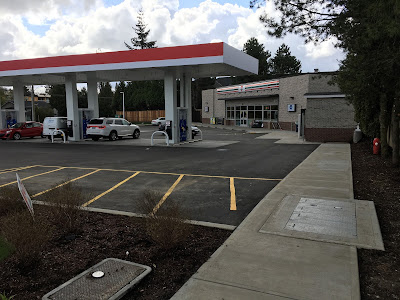Yesterday’s Langley City council meeting saw two rezoning applications, and one development permit where residents of our community could provide feedback to council. It was a full council chamber with most people interested in the apartment building proposed for the corner of 54th Avenue and 198th Street.
 |
| A full council chamber last night. Select image to enlarge. |
The first rezoning application was to accommodate a 4-storey, 62-unit apartment building at the corner of 54th Avenue and 198th Street.
 |
| Rendering of the proposed apartment building located at 198 Street and 54 Avenue. Select image to enlarge. |
One of the challenges along 198th Street is increased motor vehicle traffic. There was a Metro Vancouver construction project a year or so ago which required traffic to be detoured via 198th Street. After the competition of the 200th Street project, people continued to use 198th Street as a shortcut. Speeding is a concern along this street.
People are also parking in unsafe manners along 198th Street; people are parking too close to intersections, lanes, and building entrances.
Three people at the public hearing expressed concern about parking and traffic. The City will be adding traffic calming near Brydon Park at the corner of 198th Street and 53rd Avenue this year. In addition, the 54th Avenue/198th Street intersection will receive curb bulges which will reduce speeding, make walking safer, and reduce illegal parking in that area.
I believe that traffic calming including curb extensions and lane-narrowing will be required along all of 198th Street. A parking management plan will also need to be developed in my opinion.
One of the residents was concerned about development in general along 198th Street though that area has been zoned for high density for several decades. Another resident was concerned about light pollution from the proposed apartment building. It was noted that the type of lighting used should limit light pollution.
The second apartment building which people could provide feedback about was for a 5-storey, 88-unit building along 201 A Street at the site of the Carroll Court and Merton Court buildings which are currently being demolished.
 |
| Rendering of the proposed apartment building along 201A Street. Select image to enlarge. |
This area has been a crime hot-spot in the past, and it was noted that the proposed apartment building should reduce crime in the area due to its design which will result in more eye-and-ears on the street.
In the past, there has been issues with construction workers using on-street parking which has concerned residents. The proponent of this project is looking to find off-site parking to reduce this issue.
Carroll Court and Merton Court were affordable rental buildings. The proponent of this project ensured that all residents were able to find new homes which is critically important in redevelopment projects such as this.
There were no residents at the council meeting that spoke to this rezoning application.
Some of the common features of these buildings include electrical vehicle charging stations, and both visitor and resident bike parking. Including electrical vehicle charging stations in apartments and townhouses is a regional priority, and I’m happy to see that developers in Langley City are doing their part to support this initiative.
The last feedback heard was for a proposed subdivision application and development permit along Grade Crescent and 46 A Avenue near 206th Street. One resident at the council meeting expressed concern about the proposed new lot frontage along 46 A Avenue, and the lack of continuous sidewalks along 46 A Avenue. I noted that the lot frontage created by the proposed subdivision would be like other nearby lots. City staff noted that building a continuous sidewalk along 46 A Avenue is part of this year’s capital improvement plan.
 |
| Subdivision of lots along 46 A Avenue and Grade Crescent near 206th Street. Select image to enlarge. |
Of concern was the removal of 75 trees to accommodate the proposed development. The City is requiring that 25 trees be replanted, and that the developer pay the City for the 50 trees that won’t be replaced as per our current policy. This money will be used to plant other trees in the community.
Our tree canopy is important for a host of reasons including to provide water management, and cooling during the summer. Ensuring that we have a plan to maintain or grow our tree canopy is important.
This subdivision application and development permit were approved by council.
Tomorrow, I will be posting about other items that were on the agenda of last night’s council meeting.


























